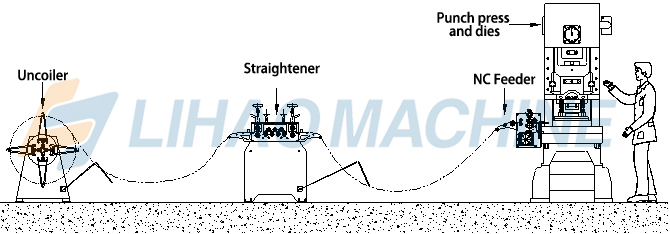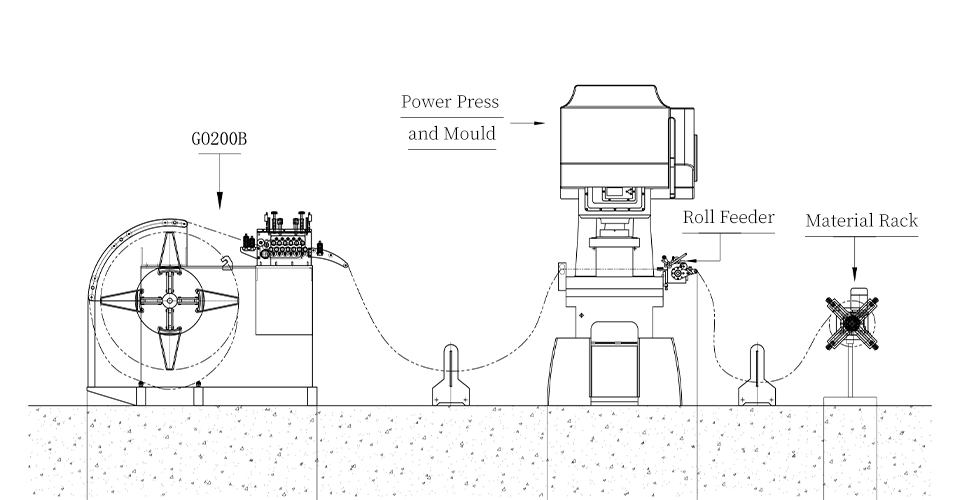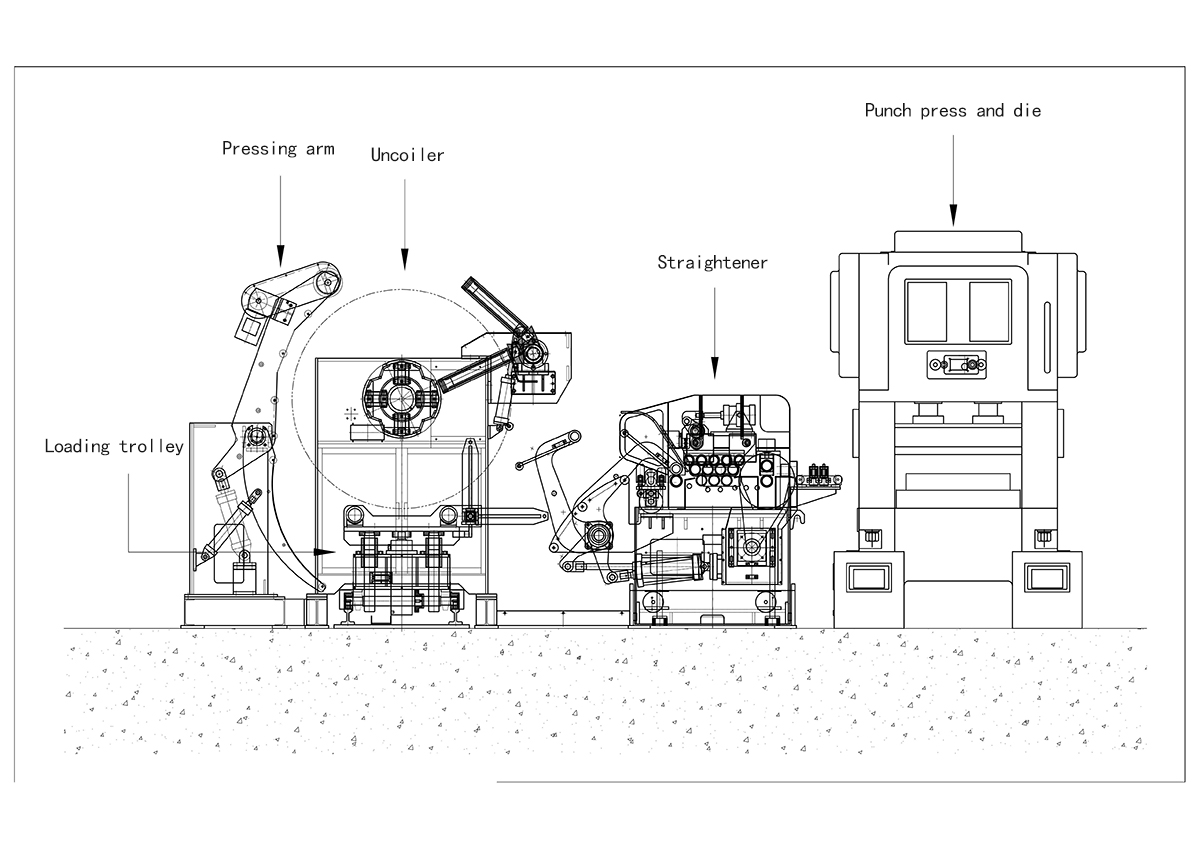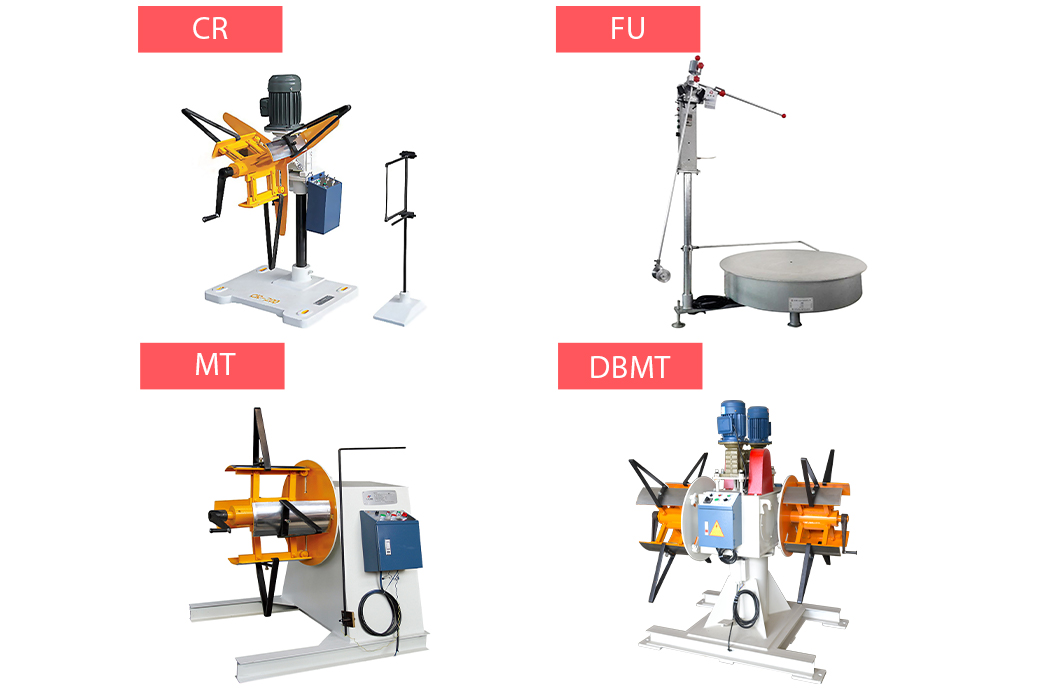I. Overview of Stamping Automation
1. What is Stamping Automation?
Stamping automation refers to the use of automated equipment (material racks, straighteners, feeders, etc.) in an online configuration to replace manual labor in the entire process of coil loading, straightening, feeding, stamping, and finally collecting, achieving efficient, stable, and safe continuous production.
2. Why Implement Automation?
- Improve Quality and Efficiency: 24/7 continuous production significantly increases production capacity and consistency.
- Reduce Costs and Emissions: Reduce labor reliance and skill requirements, lower management costs and material loss.
- Safety: Human-machine isolation eliminates safety hazards associated with manual operation.
- Stability and Precision: Automated feeding and straightening ensures feeding accuracy and extends the life of molds and punch presses. 3. Core components of automated production lines
A standard stamping automated production line usually consists of three parts:
- Loading and unwinding: Material rack
- Material leveling: Leveler (leveler)
- Precision feeding: Feeder (servo, roller, air)
- Subsequent coordination with punch press and die
(1) Split stamping production line: Material rack + leveler + feeder + punch press + die
- The wiring takes up a large area and the site utilization rate is not high.
- The degree of automation is not high and the work efficiency is not high
- It is suitable for customers with low production requirements and limited investment budget.

(2) Two-in-one + feeder stamping production line: Material rack and straightener two-in-one + feeder + punch press + mold
- Material rack + straightener integrated into one, saving space.
- The most typical stamping production line, suitable for customers with low production requirements and limited investment budget.

(3) Three-in-one stamping production line: material rack, straightening machine, and feeder + punch press + die
- The material rack + straightening machine + feeder are integrated into one, with high integration and suitable for compact spaces.
- Suitable for the production of large parts, with a high degree of automation, and can be flexibly recommended according to customer needs.

II. Detailed Explanation and Selection Guide for Core Equipment
1. Decoiler - The "Warehouse" of the Automation Line
(1) Function: Loads and unwinds steel coils.
(2) Types:
- Vertical (e.g. CR/MT/DBMT series): Cantilever structure, customizable according to customer needs.
- Horizontal (e.g. FU series): Load-bearing structure, suitable for narrow materials.

(3) Key parameters for selection:
- Load-bearing capacity (tonnage): determines how much weight the coil can hold. This involves motor power selection.
- Inner diameter (ID)/outer diameter (OD) of the coil: must match the coil size.
- Material thickness: When the material thickness is ≥1.6mm, it is strongly recommended to install a pneumatic pressing arm to prevent loose coils from injuring people. This is an important safety selling point!
2. Leveler - "Quality Control Center" of Automation Line
(1) Why is leveling needed? During rolling and transportation, coils will generate internal stress, bends, and twists. Direct stamping without correction will result in inaccurate product dimensions, increased mold wear, and a surge in scrap rates. After the initial processing, the raw material has uneven curvature and internal stress. Generally, thin materials with low precision requirements (such as simple jewelry buckles and simple daily necessities) can be used directly without correction. However, most materials must be straightened to ensure the life of the mold and the consistency of the size of the punched products during use.
(2) Working principle: The material is repeatedly "reversed" by multiple sets of staggered correction rollers to eliminate internal stress and make it straight.

(3) Key points: The more straightening rollers there are and the smaller their diameters (while ensuring rigidity), the higher the leveling accuracy will generally be.
Note: The correction capacity is limited and needs to be comprehensively evaluated based on the material thickness, width, and strength. Since the upper roller of a conventional straightening machine is unpowered and passive, it is not suitable for straightening materials with high precision or high surface requirements.
3. Feeder - The "manipulator" of the automation line
(1) The feeder is the core of precision and should be recommended based on the customer's speed, precision, and budget.
Type | Principle | Advantages | Disadvantages | Applicable Scenarios |
Air feeder
| Pneumatic drive | Low price, high accuracy (±0.1mm), requires a release solenoid valve, and can feed irregular/flexible materials. | Slow speed (<12m/min), poor stability, sensitive to airflow fluctuations | Low-speed, small-batch, multi-functional applications |
| Roller feeder | Mechanical drive (punch output shaft drive) | Fast speed (20m/min), high accuracy (±0.05mm), and good synchronization of rigid release. | Complex debugging, mechanical dead spots, and easy slippage of thick materials at high speeds | Continuous stamping for medium- and high-speed applications, conventional materials, and limited budgets |
| NC servo feeder | Servo motor drive | High speed (up to 45m/min + customizable), high accuracy (±0.02mm), intelligent (allows for any feed length), and simple debugging. | Highly expensive, requires protection against electromagnetic interference | The mainstream choice for medium- and high-speed applications, high precision, and frequent line changeovers for multiple products |
III. Stamping Coordination and Production Line Integration
Stamping Curve Diagram: Understanding the timing relationship between the punch press slide movement, mold closing, and the feeder feeding/releasing is crucial to successful commissioning. The feeder must complete feeding within the mold's fully open window.






